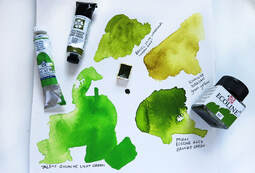 In this month’s blog post, I will continue by sharing tips on selecting watercolor paint for creating professional fine art. There are several attributes to consider when thinking about when using watercolors such as quality, color, permanence, transparency, as well as different brand selections. Watercolors has been my number one source for painting in color. It allows me to create interesting brush effects and highly saturated values without compromising the integrity of the paper. Rather you are a beginner or a professional, figuring out the right combination can bring out the best details in your fine art, sketches, and designs. There’s a variety of paper and paint brands out there for you to choose from ranging from $5 to $500. But all of the watercolor paints contain two main ingredients: finely ground pigment (which provides the color) and gum arabic (which acts as a binder). Manufacturers also add a wetting agent to facilitate flow and absorption, and a moisturizer to stop the gum binder from becoming brittle. Quality Professional Artists' watercolors are more expensive and have a higher concentration of finely ground pigment with high permanence ratings. The benefits will surely outweigh the costs in terms of permanence, intensity, and superior transparency, will last for generations. Beginner’s watercolors may contain cheaper pigments and more fillers and extenders. Your choice depends on what you can afford. Color If you're buying your first watercolor set, start off with a professional artists' quality set or students' quality set (depending on your budget) from a reliable brand and you'll have a good starter color palette that you can add to as needed. Many come with a variation of color values so that you don’t have to make them from scratch. Choose between pans or tubes according to how large your painting will be. You can also experiment with mixing different brands for vibrancy and lightfastness. Permanence Permanence (also called lightfastness) refers to the ability of the paint to withstand exposure to light and humidity without fading, darkening or shifting color. It helps artists to choose colors based on how they will appear as well as how permanent the finished artwork. Lightfastness is shown with an ASTM rating for the pigment. The ASTM abbreviation stands for the American Society for Testing and Materials. This organization has set standards for the performance of art materials including a color’s lightfastness. In this system I is the highest lightfastness available and V is the lowest, though both ratings I and II are considered permanent for artists' use. Look for the ASTM rating on the packaging and accept nothing less than "Excellent" or "Very Good" lightfastness. If a particular brand paint is labeled as N/L meaning "Not Listed", this usually indicates that the pigment or the type of range has not yet been tested by the ASTM. It does not necessarily indicate a lack of lightfastness. Transparency Certain watercolors are more transparent than others. Of course, all watercolors can be made transparent by diluting them with water, but certain pigments hide the underlying paper (or previous wash of color) more than others. Look at the transparency rating when comparing watercolors - Paints are usually categorized as “transparent”, “semi-transparent”, or “opaque”. Pans or Tubes Watercolor paint comes in two different formats: tubes or pans. Tubes are filled with liquid paint, whereas pans are little containers with dried cakes of paint in them. Tubes give you the best of both worlds and can be squeezed right from the tubes for convenience. The paint will slowly dry out, and can easily be re-wetted without any loss of handling quality. You may find it difficult to find paints that perfectly match all your criteria at once. When picking a new color the first things I look for are good transparency and single pigments. If this isn’t possible then I try to get the next best characteristics. Most watercolor paints have very good lightfastness and will still last for many years. I hope this was very helpful in making your selection with the many different brands of watercolors. Until next time, be creative in all that you do! Best Watercolor Paint (Professionals) Schmincke Horadam Watercolors Sennelier La Petite Aquarelle Watercolor Grumbacher Watercolors M. Graham Watercolors Winsor & Newton Professional Watercolors Best Watercolor Paint (Beginners) Winsor & Newton Cotman Watercolors Royal Talens Van Gogh Watercolors Reeves Watercolors Master's Touch Watercolors
0 Comments
Leave a Reply. |
welcomeHello and welcome to my blog. Here I will share videos of projects, lessons, stories, upcoming events, and sites of use, Archives
July 2020
Categories |
Copyright © 2023 | williemorrisfineart.com | Contact Us


 RSS Feed
RSS Feed